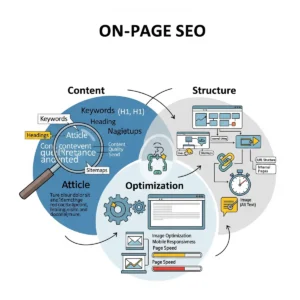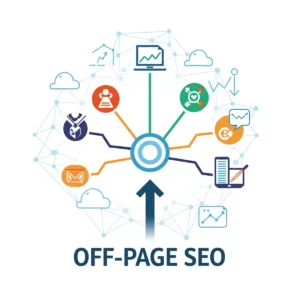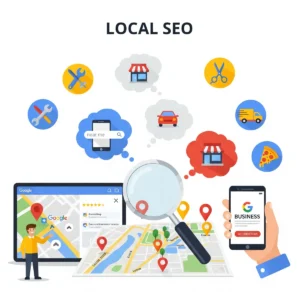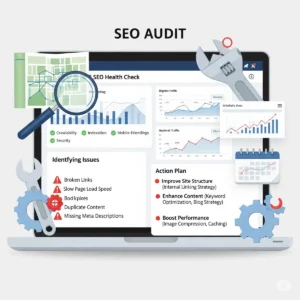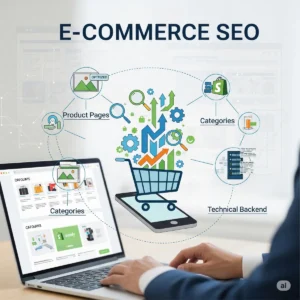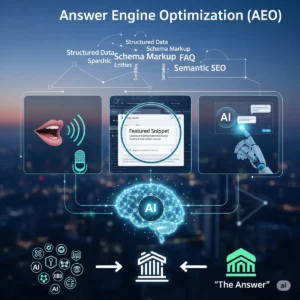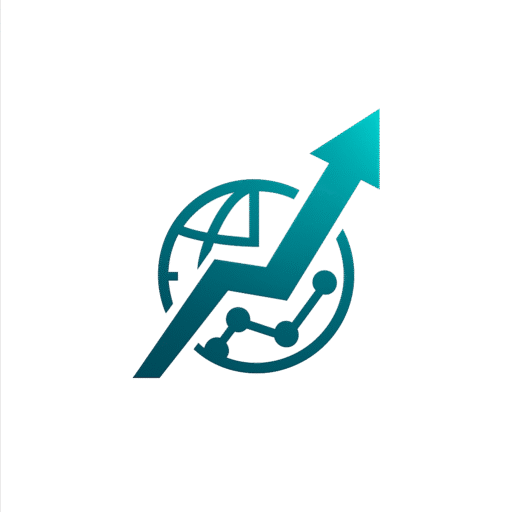What Is On-Page SEO?
When I first began working with websites, I underestimated how much on-page SEO could influence rankings and traffic. It wasn’t just about stuffing a keyword into the HTML or sprinkling links across a page. The real value came from understanding how search engines interpret a webpage and serve it to users based on queries. On-page SEO is a practice that focuses on optimizing the elements within the site—from the source code to the content itself. It’s about making your page relevant, useful, and easy to navigate, so when a human visited, they’d clearly see the good in it. And when search engines crawl it, they’d reliably identify it as worthy of a higher position on the SERP.
Unlike off-page SEO, which involves external factors like backlinks, social media presence, and distinct signals from across the internet, on-page SEO is something you can control directly. It’s the ultimate way to enhance your site’s rank by optimizing what’s within your webpage. From crafting high-quality content that addresses the search query, to structuring your HTML and source code properly, it’s all about helping both users and search engines see the essence of your page. I’ve found that when you form your SEO strategy around these basics, you’re not just trying to earn clicks—you’re attempting to build something reliable and valuable.
In my experience, the goal is to collectively align every element of your website with the queries your audience is searching for. That means understanding the search engine optimization landscape, knowing the two sides—on-page and off-page SEO—and making sure your content is optimized to meet both user intent and search engine expectations. Whether it’s a keyword in the title, a proper internal link structure, or ensuring your page loads quickly, every detail matters. The thought behind each decision should be to consider how it helps your webpage become more relevant, more useful, and more likely to rank well.
Why Is On-Page SEO Important?
When I first started optimizing individual pages on my website, I realized that on-page SEO wasn’t just about targeting the right keywords—it was about crafting content that could truly stand out. The goal was to drive targeted traffic, not just random clicks. By focusing on how each page could improve user experience, I saw a noticeable drop in bounce rate and an increase in dwell time. That meant users were actually staying to read what I had to say. And when your content aligns with search intent, it naturally begins to rank better in search engines. I’ve had subscribers and even customers come through just because the page loaded fast, looked clean on desktop and mobile devices, and delivered real value.For more Information Visit Ashir Digitals.
What makes on-page SEO so powerful is its ability to influence rankings directly. When you optimize your website for click-through rate, page loading speed, and ensure your keywords are placed with intent, you’re not just chasing metrics—you’re building trust. Every optimized element helps convert visitors into subscribers or customers. And when your pages are structured to meet both search engines and users, the results speak for themselves. It’s not just about being visible; it’s about being relevant, fast, and engaging. That’s how you drive meaningful traffic and climb the ranks.
A Quick Way to Do On-Page SEO
One of the fastest ways I’ve found to implement effective on-page SEO is by using a reliable checklist and tracker. Tools like Semrush offer an all-in-one suite that helps simplify the processes and fast-track your efforts. I always follow a step-by-step guide that lets me tick off each task as I go—from placing the keyword in the h1 and body, to checking locations that really matter. These tools aren’t just for pros; they’re built to show you what to do, cover the aspects that need attention, and ensure your pages are fully optimized. Even if you’re just starting out, having actionable suggestions and insights can make a huge difference.
Personally, I’ve used this approach to enhance content across dozens of client sites. What makes it work is the ability to update quickly and know exactly what to fix. The overview feature helps you make informed decisions, while the companion tools help you use related keywords and avoid expensive mistakes. Whether you’re optimizing one page or an entire site, this method helps you do the important things without getting overwhelmed. Just open your checklist, follow the prompts, and you’ll be surprised how much you can improve in a short time.
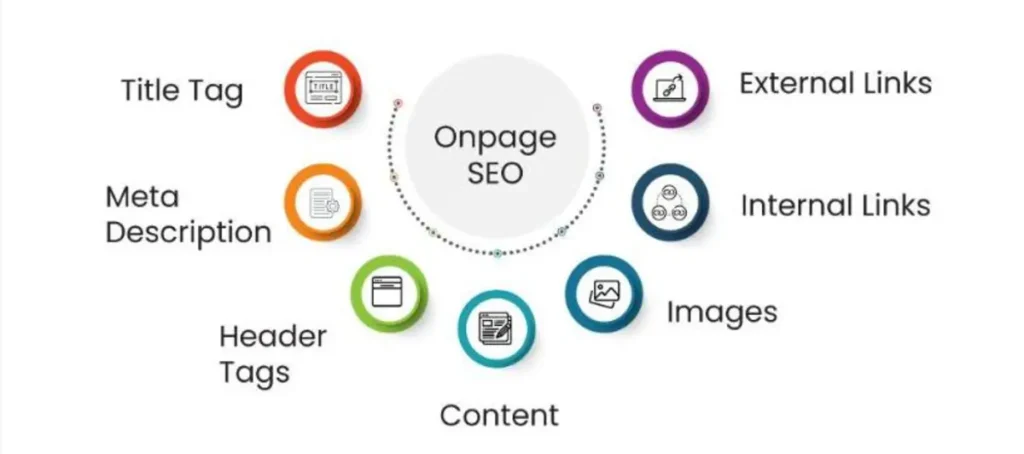
Here are key on-page optimization techniques to consider:
Write unique, helpful content
Place target keywords strategically
Write keyword-rich title tags
Write click-worthy meta descriptions
Use headings and subheadings to structure your page
Optimize URLs
Add internal links
Add external links
Include and optimize images
1.Create Unique Content
When I first began publishing SEO-driven articles, I quickly learned that regurgitating existing ideas led to duplicate content that barely moved the needle on Google’s SERP. To truly stand out, I shifted toward crafting unique, fresh, and new pieces that offered real information gain—not just another post stuffed with keywords repeated too many times. I started incorporating curated resources, embedding case study insights, and designing downloadable checklists with a streamlined, step-by-step process that improved both UX and design. One effective strategy was flipping common topics—rather than just talking about what works, I explored why certain strategies fail, backed by real examples and actionable tips. I also built visual lists and tables that made complex ideas digestible, helping my pages rank for competitive terms simply by using a more thoughtful approach. Updating older content with new insights and better structure helped me reclaim lost rankings, proving that being enough in value—not just volume—is what drives results.
2.Keywords, content, and on-page SEO
In my years of optimizing webpages, I’ve seen how on-page SEO has grown from simple exact-match keyword stuffing to a nuanced art that demands context, intent, and strategic placement in the right locations. Whether you’re a newcomer or experienced, understanding how search engines extract meaning from content is crucial—especially when algorithms now favor synonymous phrases, secondary terms, and natural combinations that appear throughout the topic. I always start with a checklist that includes HTML structure, frequency control, and guideline adherence to avoid thin or duplicated content, which can trigger Google Panda penalties.
A user-friendly, readable, organized, and navigable website not only improves ranking but also fulfills the need of users who are looking for reliable, authoritative resources. I’ve learned to monitor and update pages regularly, ensuring they stay aligned with current trends, queries, and expectations—because a term that was once high-value may lose relevance if not refreshed. By using synonyms, avoiding unnecessary repetition, and placing keywords in expected places, I’ve helped clients get ranked for competitive terms while keeping their content clean of excessive ads or affiliate links. The tenant of modern SEO is no longer just about being mentioned—it’s about being trustworthy, unique, and delivering in-depth value that helps search engines and humans alike understand your pages as a reliable resource on the Internet.
3.Make Click-Worthy Titles
One of the most important lessons I’ve learned in crafting click-worthy titles is that they must serve both users and search engines simultaneously. A strong title tag isn’t just a catchy phrase—it’s a strategic asset that influences ranking, positions, and how your page appears in the overview of organic research tools like Semrush. I always frontload the keyword at the beginning, especially when targeting long tail terms, and use modifiers like “best,” “free,” or “fast” to boost engagement. The content must match the search query with precision, and the titles should make sense to both humans and site crawlers. A well-structured checklist helps me ensure each title is unique, avoids duplicate phrasing, and aligns with on-page SEO factors like image SEO, HTML formatting, and relevant keywords.
My process often begins with brainstorming using AI tools like ChatGPT and a reliable keyword generator to generate multiple variants and ideas. I then run a site audit to identify weak or repetitive titles and refine them using insights from SEO tools. A solid pro tip is to include a benefit-driven phrase—something that promises value, like “Free Guide to Improve Rankings Fast”—which not only gets highlighted in snippets but also drives the click. For example, when I optimized a client’s blog post with a title like “Best SEO Checklist for Fast Growth,” it instantly gained traction because it hit all the right signals: target keyword, emotional pull, and clarity. Titles aren’t just labels—they’re the gateway to your content, and when done right, they elevate your entire site.
4.Optimizing title tags and meta descriptions
When I first began refining title tags and meta descriptions, I treated them like minor elements of on-page SEO—until I realized they were often the only thing standing between a user’s click and a missed opportunity. These snippets on search engine results pages (SERPs) don’t just describe your content—they entice, summarize, and include the most essential signals that help both users and search engines understand your page. I always make sure the title tags are concise, compelling, and accurately reflect the target keyword, ideally placed near the front. A descriptive yet brief headline can dramatically improve visibility and engagement, especially when paired with a meta description that feels like a promise fulfilled.
My approach to optimizing these elements starts with understanding the content deeply—what’s the real value, and how can I convey it in under 160 characters? I use emotional triggers, urgency, and clarity to make the meta descriptions stand out, often testing variations to see which one performs best. For example, a page about dental SEO might have a title tag like “Target Local Patients with Dental SEO” and a meta description that reads “Learn how to attract more patients with our concise, actionable dental SEO guide.” It’s descriptive, compelling, and brief, and it speaks directly to what the user is looking for. These small tweaks have helped my clients dominate SERPs and dramatically increase their click-through rates.
5.Use Your Target Keyword in the First 100 Words
One old-school yet still incredibly effective on-page SEO tactic I swear by is placing the target keyword within the first 100-150 words of an article. It’s not just about tradition—it’s about signaling to Google that your content is optimized and relevant from the get-go. When I write about email marketing or the keto diet, I make sure the term I want to rank for doesn’t appear halfway down the page, where it loses weight and impact. Instead, I mention it right off the bat, in a way that makes sense and feels natural. This helps both readers and algorithms understand what the article is about early on, which can lead to higher rankings. I’ve seen published pieces drop in performance simply because the keyword was buried too deep, and once I revised the content to show the terms earlier, the results improved dramatically. It’s a simple move, but an important one that reinforces relevance and clarity.
6.Targeting featured snippets
When I first started optimizing for featured snippets, I underestimated how much visibility they could bring to a website. These prime spots at the top of search engine results pages (SERPs) act like digital billboards, offering a summary of your content that directly answers the user’s query. To increase your chances of appearing, you need to optimize your page with a clear, concise answer that’s easy for both users and algorithms to understand. I’ve found that structuring the content with bullet points, numbered lists, or short paragraphs helps tremendously—especially when the target keyword is placed strategically near the top.
One technique that’s consistently worked for me is using schema markup to help search engines better interpret the content. It’s not just about writing well—it’s about making your page machine-readable. I always start by identifying the query I want to target, then crafting a direct response that’s brief but informative. This approach has significantly boosted traffic for my clients, especially in competitive niches where traditional ranking is tough. By focusing on featured snippets, I’ve helped brands leapfrog to the top of the SERPs, even when their domain authority wasn’t the strongest.
7.Optimizing URLs and internal links
One of the most essential yet often overlooked aspects of improving a website’s SEO is the way you structure your URLs and internal links. Early in my career, I used long, messy URLs filled with unnecessary parameters, and I noticed how poorly search engine crawlers could navigate and understand the hierarchy of my content. Once I shifted to descriptive, concise formats that include the target keyword, not only did my crawlability improve, but users found it easier to share and revisit specific pages. A clean URL like /seo-strategy-guide tells both the search engine and the user exactly what to expect, which enhances both visibility and user experience.
Equally important is how you use internal links to connect relevant pages. I always make sure the anchor text is meaningful and not generic like “click here.” Instead, I’ll link phrases like “learn how to optimize your meta descriptions” to a guide that expands on that topic. This not only helps crawlers navigate the website more efficiently but also encourages deeper engagement from users. By optimizing both the structure and placement of these links, I’ve seen dramatic improvements in time-on-page and overall SEO performance. It’s a subtle strategy, but when done right, it builds a strong internal network that supports every piece of content you publish.
8. Include and Optimize Images
When I started auditing client websites, I noticed how often images were either missing alt text or had inadequate attributes, which directly impacted their ability to rank in Google Images and reduced overall traffic. To fix this, I began writing descriptive, brief alt tags—usually under 125 characters—that explain what’s in the image while naturally including the target keyword. For example, instead of vague phrases like “image of rabbit,” I’d write “rabbit eating fresh greens,” which helps search engines, screen readers, and users alike. I always avoid using generic terms like “picture of” and skip decorative images unless they serve a functional purpose.
A Site Audit often reveals issues like missing alt tags or poor file names, so I make sure to optimize those too—renaming files with relevant keywords and compressing them to reduce file sizes, which improves page speed. I also recommend enabling lazy loading so images only appear when they enter the viewport, keeping the experience smooth and fast. These tips have helped me consistently improve rankings and engagement across visual-heavy pages.
9.Add External Links to Authoritative Sources
One of the most overlooked ways to improve user experience and build trust with your audience is by adding external links to authoritative sources. I’ve seen firsthand how Google not only recommends this practice but often rewards sites that provide value through smart linking. The key is to avoid spammy behavior and instead focus on high-quality, relevant other sites that your users would expect to see referenced. I always use descriptive, natural anchor text and maintain a healthy balance in quantity and placement—too many links can feel cluttered, while too few may miss the opportunity to enrich the content.
During a Site Audit, I often check the tab or search bar for issues and review the findings to see where outbound links can be identified and improved. Using the right tool, I’ve helped clients enhance credibility and engagement simply by linking to trusted resources like government health sites, academic journals, or industry leaders. Following these best practices has consistently elevated the perceived authority of the site and deepened the connection with readers.
On-Page SEO vs. Off-Page SEO
When I first started in SEO, I leaned heavily into on-page SEO, obsessing over title tags, meta tags, internal linking, and images—all the elements that live directly on the website and its pages. These strategies are about content optimization, ensuring each keyword is placed with intent, and that the site crawlers can easily crawl and understand the relevance of each search query. I used schema markup to help Google extract featured snippet data and relied on AI tools and analytics tools to refine every aspect of the site. It’s a traditional yet smarter approach that still matters deeply, especially when trying to enhance the individual presence of a page in a competitive SERP. I even built a custom tracker and cheatsheet to monitor search performance, making sure every signal was aligned with what Google expects.
But as I scaled my agency, I realized that off-page SEO is just as vital—it’s the difference between a well-optimized site and one that actually ranks. This involves strategies that happen outside the website, like link building, social media, public relations, influencer marketing, and local SEO. I’ve used outreach management tools to secure brand mentions and backlinks from high-authority platforms, and even optimized Google Business Profile listings to boost visibility. Through backlink analysis and report generation, I’ve seen how these signals can dramatically enhance a site’s authority and relevance. While on-page SEO is about making your pages speak clearly to Google, off-page SEO is about making others talk about you—and that’s what truly builds trust and long-term success.
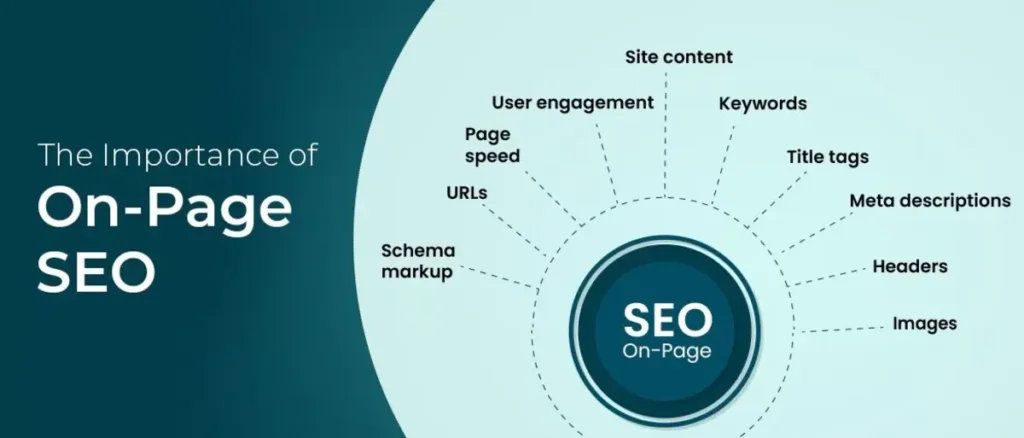
📈 Want your website to rank higher on Google?
You’ve just learned what On-Page SEO is — now let’s put it into action.
🚀 Let Ashir Digitals optimize your site for better traffic and leads.
👉 Contact us now or request your FREE SEO audit today!
Common Qustions About On Page SEO Optimization
What is on-page optimization SEO?
Onpage optimization or on-page SEO refers to actions taken directly on a website to improve its search rankings, like refining content, title tags, and meta description to optimize relevance and visibility.
What is an onsite SEO?
Onsite SEO refers to the changes made directly within a website to improve its rankings, unlike offsite SEO which relies on external factors that also impact how a site performs in search engines.
How to optimize a webpage for SEO?
To optimize a page for SEO, I start by researching trending keywords using a keyword generator, then craft relevant content that meets SEO requirements without overlap or keyword stuffing. I refine title tags, write enticing descriptions, ensure accessibility, and make sure the media is mobile-friendly. I also link to credible websites and interconnect my own content to boost authority.
What is the difference between on-page SEO and SEO?
On-page SEO refers to optimization done within the pages of a website, focusing on content, keywords, and elements that help search engines match user queries with relevant results, while technical SEO deals with the infrastructure—ensuring the site can be crawled and indexed efficiently, which goes hand in hand with overall SEO strategy.
What are the 4 types of SEO?
From my experience, the four core types of SEO include technical SEO, which focuses on website infrastructure and making sure search engines can crawl and index the site efficiently; on-page SEO, which refers to optimization within the pages through content, keywords, and elements that align with specific user queries; off-page SEO, which builds authority through external signals; and local SEO, which targets geographic relevance—all working hand in hand to boost visibility.
Is SEO better than ads?
In my experience running campaigns for clients, the answer depends on your goal—if you’re looking to drive immediate traffic to your site, PPC and ads can deliver results in the short term. But if your focus is building a sustainable online presence and enhancing your business in the long run, then SEO is where you should invest your time and energy. A well-rounded strategy often blends both to enhance visibility and growth.
https://youtu.be/4J9Aa89Klqs

